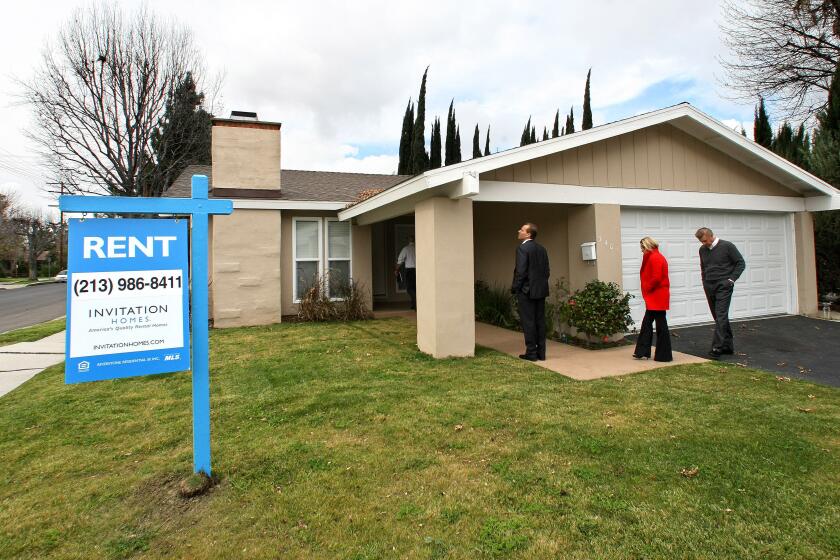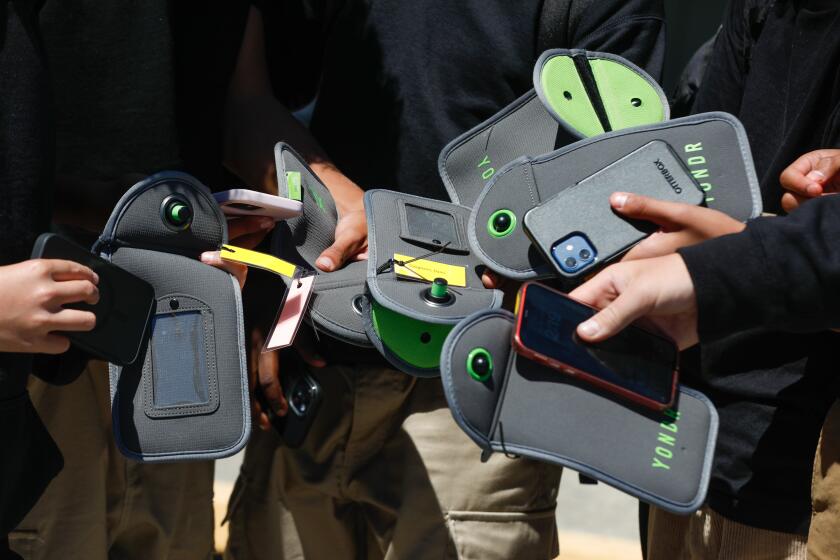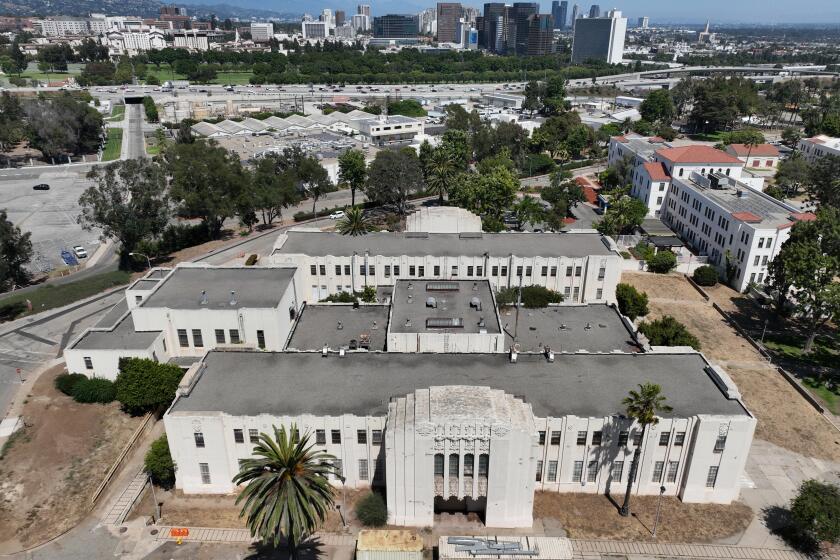Opinion: Is this the year L.A. finally takes homelessness seriously?
L.A. finally passes a unified plan to help the homeless – now the hard part begins
| Carla Hall |
On Tuesday, both the county and the city of Los Angeles approved far-reaching and ambitious plans to help homeless people off the streets through a combination of housing, rental subsidies, case management and expanded counseling, therapy and other services. This is not the first time the county and the city have tried to address the problem of homelessness. But this time, they vow, they will succeed.
County and city elected officials say that unlike in the past they are now coordinating their plans rather than working at loggerheads, and that they have a level of political will and fortitude that they never had before. “Urgency has to be the mantra of the day,” said County Supervisor Mark Ridley-Thomas.
Let’s hope they mean it.
California is rife with laws used to harass homeless people
Anti-Okie laws. Sundown towns. Ugly laws.
These old vagrancy laws recall shameful periods in our history when communities selectively persecuted and punished migrants, people of color and the physically disabled. The U.S. Supreme Court struck down California’s anti-Okie law, which made it a crime to bring anyone indigent into the state, in 1941. In a 1972 case from Jacksonville, Fla., the Supreme Court invalidated a local vagrancy ordinance because it encouraged arbitrary arrests, criminalized innocent activities and placed unfettered discretion in the hands of the police.
But those rulings weren’t the end of vagrancy laws. In their latest iteration, they target homeless people. After homelessness began skyrocketing in the 1980s, cities responded with laws that criminalize basic life activities conducted in public, such as standing, sitting, resting or sleeping, and even sharing food with homeless people. As the crisis worsened in California — 22% of America’s homeless population now lives in the state — cities have piled on more and more vagrancy laws.
Not all the public comment on L.A. County’s homelessness plan was indoors...
| Carla Hall |
While walking back to the L.A. Times after covering the L.A. County Board of Supervisors embracing an ambitious and costly plan to end homelessness, I spotted this homeless person. His sign said more than we could publish.
Whatever happened to Project 50?
| Rob Greene |
When a large enterprise like Los Angeles County government attempts something extraordinarily ambitious, such as effectively eliminating homelessness, yet repeatedly falls short, it’s sometimes hard to tell whether the rubble left by each failure forms a series of impenetrable barriers against the next attempt -- or whether it instead forms a staircase layered with experience gained and lessons learned, leading upward toward eventual success.
The County Board of Supervisors sees a staircase, and on Tuesday it will try to climb it by adopting a far-reaching homelessness initiative. Much is at stake, not least of which is the well-being of tens of thousands of county residents now living in misery and danger on streets and sidewalks, in shelters and jails.
The effort also is a test of government’s ability to sufficiently cut through its own bureaucratic knots and move past its own political jealousies in order to perform as its constituents demand -- and to vindicate democracy as a viable and meaningful system for meeting the challenges of basic human need, justice and equity.
So as the county tries again, it’s worth looking back this time to 2009, when the board rejected a proposal to expand a program known as Project 50.
L.A. County spends a cool billion per year on homelessness
| Matthew Fleischer |
If these are the results of our recent efforts to fight homelessness, it begs the question of what an extra $100 million will do.
From a street corner to a room of his own
| Carla Hall |
I met James Lonon as he sat on a concrete bench at 22nd and Wilshire Boulevard in Santa Monica in mid-November of last year. He was neatly dressed, a small cart of belongings at his side and a crisp brown bag set up at his feet for offerings of cash from passers-by. He smiled warmly as I approached.
We began chatting. He had been homeless a year, he told me, after his unemployment benefits ran out. In 2014, he lost a nine-year job as a clerk at a big retailer. He had a bachelor’s degree from Cal State Long Beach, he said.
On the corner, he was adept at making money and acquaintances.
“All the people out here in Santa Monica — it would seem like they would have an empty room that they would offer,” he said.
He did better than that. Marsha Temple and her colleagues at the nonprofit Integrated Recovery Network found him housing and got him signed up for General Relief. Today, Lonon has a room of his own in a six-bedroom apartment just west of USC that functions as transitional housing. Next week, he starts a part-time job. But his journey is just beginning.
From jail to skid row, where ‘all healing needs are met’
| Robert Greene |
Peter Starks describes the experience of a typical inmate leaving jail or prison and confronting a mound of paperwork. Fill this out and go here for treatment. Fill that out and go there for housing.
“Before you get there, you’ve got skid row, where all your healing needs are met,” Starks says. “The dope man is going to get paid. So getting to you people — it’s not going to happen.”
He is speaking to an audience of service providers from public and private agencies that try to help people leaving jail and prison from ending up on the street.
What L.A. can learn from a Portland homeless encampment
| Matthew Fleischer |
If L.A.’s recent history is any indication, there is no one-size-fits-all solution to fighting homelessness. If city and county officials hope to make a dent into getting the region’s roughly 44,000-strong homeless population the help they need, it’s going to take a multipronged approach.
Portland, Ore., may offer one elegant solution in the form a of progressive homeless camp on the outskirts of the city.
It’s called “Dignity Village,” and it costs local taxpayers nothing.
L.A. city or L.A. County: Who’s responsible for homelessness?
| Robert Greene |
Imagine the father of two young children. He gets arrested and sent to jail, and the children are sent to foster homes. The public is now paying to house and supervise three people in three places.
Because he’s in jail, he loses his job and can’t pay his rent. So he also loses his apartment. When he leaves jail, he’s sleeping on the street.
Can we use the money we’re spending on the kids in foster care to get him an apartment, so he can get his kids back? No new money needed, no new housing needed, family back home instead of on the street or living with strangers. Who in Los Angeles is thinking this stuff through?
How does L.A.’s $100-million plan stack up to New York’s spending?
| Matthew Fleischer |
According to The Rev. Andy Bales, CEO of the Union Rescue Mission, not very well.
Over 70% of people experiencing homelessness [in L.A.] don’t have a roof over their heads at night, and New York is embarrassed because they have about 4%. They spend a billion a year on homelessness issues. L.A. needs a basic heart change.
Michael Antonovich: This time, county supervisors are serious about ending homelessness
County Supervisor Michael Antonovich took issue with our assessment that the county’s current $100-million plan to fight homelessness eerily resembles its failed 2006 version.
He writes in a letter to The Times:
Unlike the fragmented board of years past, the supervisors serving today are committed to facing problems without the divide-by-five mentality to truly ensure that people leaving foster care, domestic violence, hospitals, jails, shelters and other institutions are not simply released to the streets.
Read more from Antonovich here.
Figuring out where homeless people are, and where they are not
| Carla Hall |
Larry Watts, an attorney, steers his BMW off Sunset Boulevard and onto private Evans Road in Brentwood. In the front seat next to him sits Chip Tardif, a retired fire captain and paramedic, with a clipboard. I sit in the back with a flashlight. It’s the second night of the Los Angeles County homelessness count and, as volunteers, our mission is to do a visual survey of any homeless people we find sleeping on a sidewalk or doorway or park or hunkered down in a vehicle.
There’s no question that there are homeless people in Brentwood. There are busy streets here, densely lined with apartment buildings and condos and businesses, where homeless people sleep or park their RVs. But the census tract to which we have been assigned is the rarified Brentwood of hillsides and horse paddocks, rambling houses ablaze with lights and others set so far back behind gates that they are invisible in the black of the night.
Watts knows these enclaves well. We meander the streets of the Brentwood Riviera. “That’s Steven Spielberg’s house,” he says as we pass a gate and crane our necks for a glimpse of nothing but darkness. Watts is chairman of the Brentwood Community Council and gets involved in issues facing the community. “The plight of the homeless is certainly one of them.” This is his second year volunteering for the count.
“I lived in my car for a year when I was at UCLA,” Tardif says. He did it to save money on housing. “It was more of a choice.” As a paramedic, he spent years talking with and treating homeless people he met on the streets, some of them so frequently that he could tell who was calling for help before the call was answered. “Some areas I could tell you who was calling by the pay phone they were calling from.”
After an hour and a half, we spot zero homeless people and one skunk.
“We didn’t find anyone last year either,” Watts says.
That doesn’t mean our foray was wasted. It’s as important to know where homeless people are as where they are not.
How is the new homeless plan different? Mark Ridley-Thomas responds
The VA lays out its plans for homeless veterans in L.A.
More than 125 years ago, two founders of the city of Santa Monica gave 300 acres to the federal government to provide a home for veterans. Over the years, the Department of Veterans Affairs’ now-388-acre campus in West Los Angeles has provided homes to a college baseball stadium, a commercial laundry, a rental car lot, a high-school swimming pool ... but no permanent ones for homeless vets, aside from a new, state-operated retirement home that was built without a kitchen.
That’s about to change. On Thursday the VA unveiled a final version of a new master plan for the West L.A. grounds, including at least 1,200 units of permanent supportive housing. It’s about time, says The Times’ editorial board.
How should L.A. spend its $100-million homelessness emergency fund?
| Matthew Fleischer |
We asked seven homelessness activists to weigh in. Their answers might surprise you.
For a little international perspective ....
I wonder if London defines that as a shelter crisis or a state of emergency.
A night on the streets in East L.A.
| Carla Hall |
A woman is huddled in a dark doorway across the street. Is she homeless? None of us can tell. We scurry across the expanse of Whittier Boulevard for a closer look. As soon as we get to the other side, we see she is talking on a cellphone and looks perfectly … not homeless.
Much of this counting involves close scrutiny — people have a way of ingeniously hiding themselves in corners — and judgment. It’s better than not counting, but this is an estimate at best.
Tell us why this homelessness plan will work when the others failed
| Robert Greene |
News flash: The Los Angeles County Board of Supervisors allocated $100 million to fight homelessness and came up with plans to make sure that inmates leaving prison and patients leaving hospitals don’t end up on skid row. Joining with L.A.’s mayor, they called a news conference to announce that this time, finally, they really meant it: They would end homelessness. They had the money, the will and the momentum to succeed where their predecessors had failed.
And they acknowledged that they had better not blow it this time, as they had done so many times before. One supervisor told The Times that he and other elected officials had “an opportunity that will not pass our way again in our political lifetimes.”
And he was right. The county allocated that money and crafted those plans, and Supervisor Zev Yaroslavsky made that statement, in 2006....
When the subway becomes a shelter
| Kerry Cavanaugh |
For the first time, Los Angeles officials will attempt to count the number of homeless people in the subway system.
Volunteers from the Los Angeles County Metropolitan Transportation Authority will tally the number of people sleeping or seeking shelter in stations on the Red Line, Purple Line and the Gold Line extension to East L.A.
It’s no surprise that men and women have moved out of the cold and into the relative warmth and security of the subway lines. But until now, no one has attempted to count the number of homeless individuals using the rail lines for shelter.
Volunteers will conduct the count Thursday night, the same day that Metro’s Board of Directors will discuss declining ridership. One possible reason? Customers have complained that they feel unsafe and uncomfortable taking the bus or train. So, how will the number of homeless people using the system fit into that discussion?
Does this guy look homeless to you?
| Matthew Fleischer |
In case there are any doubts about the difficulty of getting an accurate homeless count, meet Louis Tse.
Sign up for Essential California
The most important California stories and recommendations in your inbox every morning.
You may occasionally receive promotional content from the Los Angeles Times.






